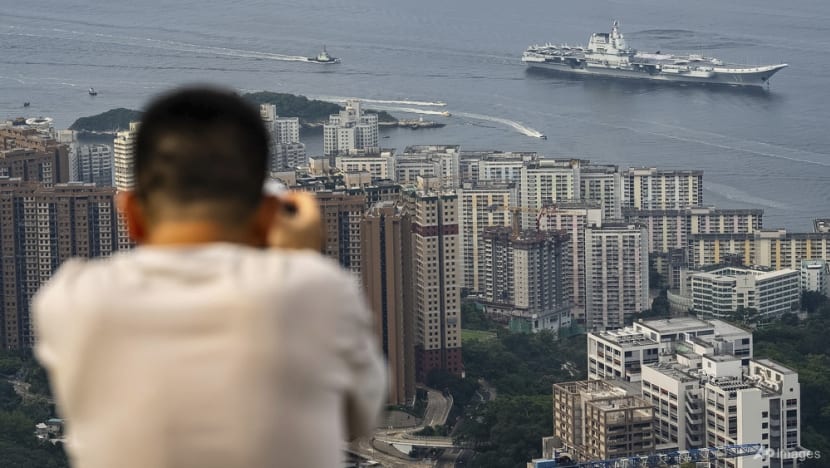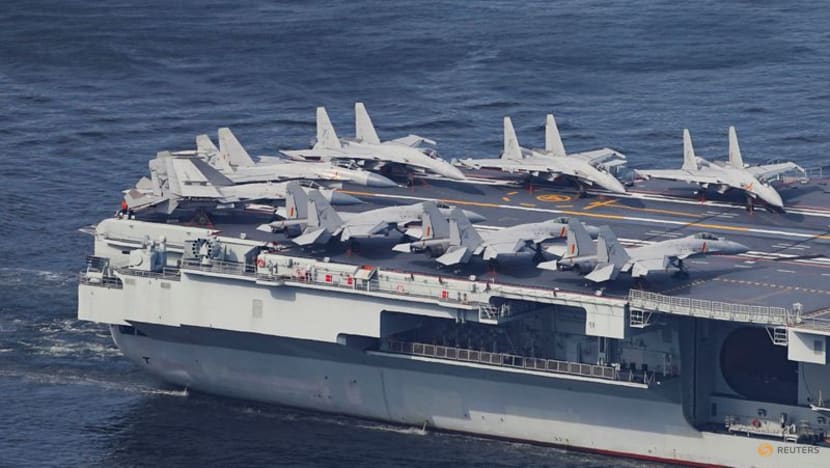China’s Shandong aircraft carrier's visit to Hong Kong signals growing military ambitions: Analysts
The visit comes just days after Hong Kong marked its 28th anniversary of return to Chinese sovereignty.

China's first domestically built aircraft carrier Shandong sails into Hong Kong for port call Thursday, July 3, 2025. (AP Photo/Chan Long Hei)

This audio is generated by an AI tool.
HONG KONG: China’s first domestically built aircraft carrier, the Shandong, wrapped up a five-day port call in Hong Kong on Monday (Jul 7), in a move analysts say reflects Beijing’s intent to advance its military ambitions amid rising geopolitical tensions.
Named after the Chinese province of Shandong, the vessel is China's second carrier and a cornerstone of President Xi Jinping’s strategy to project naval power, particularly in disputed waters in the South China Sea.
Its Hong Kong visit came just days after the city marked the 28th anniversary of its return to Chinese sovereignty.
REGIONAL PRESENCE
Alejandro Reyes, an adjunct professor at the University of Hong Kong’s politics and public administration department, said he does not believe the purpose is to signal that China is positioning itself as “a rival” to the United States.
“Besides the idea of generating or cultivating patriotism in Hong Kong, I think it’s a more modest strategic objective just to show that China is a developing and emerging naval power in the region,” he added.
“This is China saying: ‘This is our neighbourhood, this is our internal waters’. So, whether the Shandong is in Hong Kong or not, it’s immaterial.”

However, Rex Li, international relations professor and research affiliate of the Lau China Institute at King's College London, thinks otherwise.
It is “about showing, demonstrating China’s capabilities, naval capabilities”, he said.
“China will continue to develop its military capabilities, its military power, especially at a time when geopolitical tensions are rising rapidly in different parts of the world," he added.
Li noted that “the important step for China now is to make sure it’s capable of responding to any crisis or events that would affect or challenge China’s economic or security interest”.
“It’s really a demonstration of power,” he added. “I don’t think it will lead to any major US-China crisis. But it will certainly send a clear signal to the US that China is prepared to fight if necessary.”
The Shandong, which measures more than 300m in length, was commissioned in 2019. It is the second Chinese aircraft carrier to visit Hong Kong, following a 2017 visit by the Liaoning.
China’s third and most advanced carrier, the Fujian, is expected to enter service this year, ushering in what state media calls the “three aircraft carrier era”.
Hong Kong’s Chief Executive John Lee said during the welcoming ceremony that the Shandong fleet visit would allow the public to "experience the magnificence and sophistication of the country's modern warships".
A STRONGER MILITARY
Many Hong Kong residents had turned out to catch a rare glimpse of the Chinese vessel and preserve the moment with photos.
“I have never seen a real aircraft carrier. I have seen military ships before but not such a big one," said Hong Kong resident Ho Wong.
“I am very happy that China has (such a vessel). It’s considered a good thing for the world, with a stronger military, the world will be more balanced, there will not be as many conflicts.”
Fellow Hong Kong resident Ng Mui Ying expressed pride, saying: “As Chinese citizens, since (the carrier) has arrived in Hong Kong, we must definitely try all means to come and see it.”
China has steadily raised its defence budget over the past decade, amid President Xi’s push to fully modernise the country’s military by 2035.
In March, it announced another 7.2 per cent boost this year.
Li said defence modernisation has always been important for China.
“From China’s point of view, it’s always preferable to achieve peace without fighting. In terms of promoting peace, I think China wants to show that peace can be achieved through military strength,” he said.
“You would not be in a strong position to negotiate with other countries, to talk about peace if this is not backed up by your military capabilities. You can only have a louder voice in negotiation if other countries can see that if negotiation breaks down, you are able to fight.”
Meanwhile, NATO (North Atlantic Treaty Organization) countries agreed last month to invest 5 per cent of their gross domestic product annually on core defence and defence-related spending by 2035.
Looking ahead, observers highlighted that China may be expected to reevaluate its own defence posture.


















